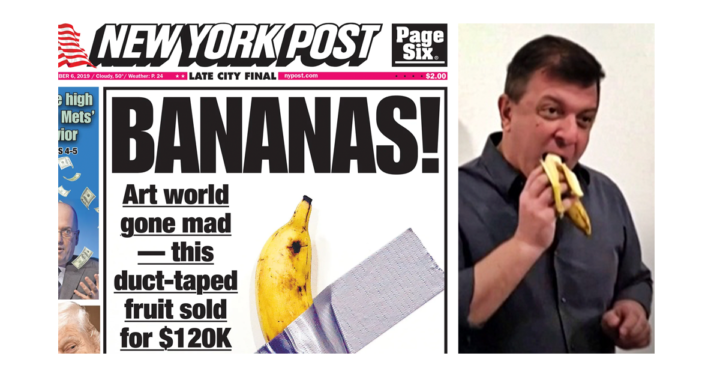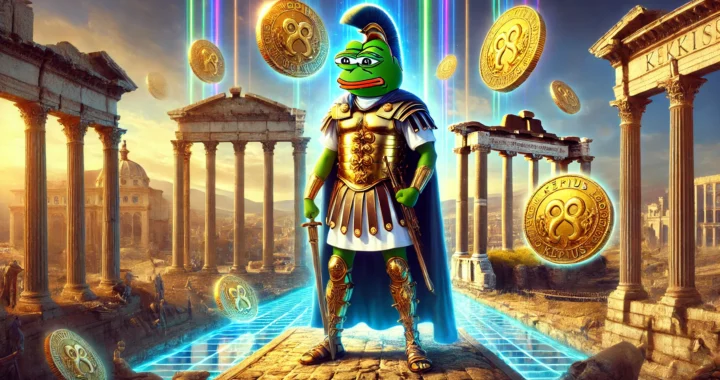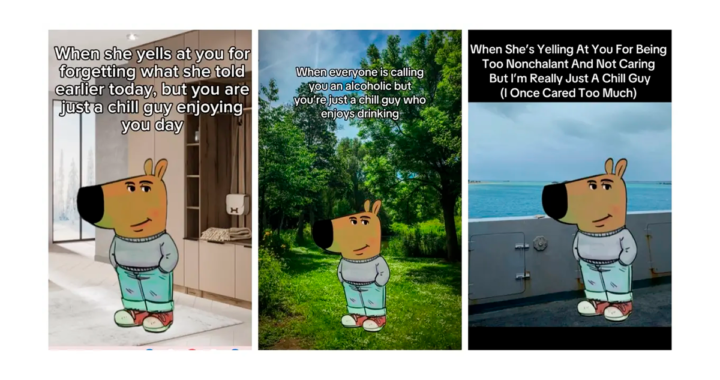In 2019, Maurizio Cattelan’s The Comedian debuted at Art Basel Miami: a banana duct-taped to a wall. It sounds like a practical joke—and maybe it is—but one that sold for $120,000. Five years later, a copy of the work fetched a staggering $6.2 million at a Sotheby’s auction. The seemingly banal piece can be easily explained as a textbook example of Kekonomics: a world where attention is the true currency, and a banana can be worth as much as a Picasso.
Not everyone quietly embraced the irony of this artwork. Performance artist David Datuna stepped forward one day, peeled the banana off the wall, and ate it, declaring himself the “Hungry Artist.” His action was caught on camera and immediately went viral. Datuna later claimed he had not “destroyed art,” but rather “created art.” And he had a point: his performance added a new layer to the narrative of The Comedian. The banana itself disappeared, but the idea—and the uproar—persisted. After all, what is conceptual art if not an invitation to play in the infinite space between idea and execution?
The “Hungry Artist” incident demonstrated that The Comedian is not just an artwork; it’s a platform for interaction. Datuna’s action brought the work to literal consumption, perfectly aligning with the absurd logic Cattelan had crafted. After all, a banana is always meant to be eaten. In the same spirit, Justin Sun, the buyer of one of the three editions in 2024, made his own contribution. During a press conference in Hong Kong, he ate a fresh banana (the original had long since been replaced) and served banana-shaped pastries to the attendees. Sun’s “performance” once again proved that the physical banana is merely a vehicle; the real artwork lies in the stories, interactions, and absurdities tied to it.
Both Datuna and Sun illustrate how The Comedian perfectly embodies the principles of Kekonomics. The work exists not just in galleries or auctions; it thrives in memes, tweets, and spontaneous performances it inspires. The piece was not only shared on social media but was also physically replicated by countless people taping bananas to their own walls. The audience actively participated, adding layers of irony and further driving up the work’s value. Every parody, meme, or tweet was not just a nod to Cattelan but also an investment in the value of the original. Every new chapter, from the “Hungry Artist” to banana pastries, drives the value even higher. The banana becomes a symbol of how we no longer pay for objects themselves but for the attention they generate.
“It’s not about the banana but what it represents,” Justin Sun explained after purchasing The Comedian. As a prominent figure in the blockchain and NFT world, Sun knew exactly what he was doing: connecting a conceptual artwork directly to the logic of the digital economy. NFTs, like The Comedian, have no intrinsic physical value; their significance lies in symbolism, ownership, and the stories they carry. Sun’s purchase was a perfect example of Kekonomics in action, where an everyday object is elevated to a multimillion-dollar cultural and economic symbol.
Sun’s acquisition of The Comedian can be seen as an attempt to explore the boundary between art and economics. The work serves as a perfect illustration of how ideas, divorced from physical objects, can create value in the modern world. Just as NFTs derive value from their uniqueness and the narrative surrounding them, The Comedian demonstrates that even a banana—or rather, the idea of a banana taped to a wall—can become an icon of the attention economy. The physical banana was incidental; what Sun purchased was a piece of history and a chance to position himself within its story. This vision aligns seamlessly with Sun’s background in NFTs, where digital ownership revolves around exclusivity and authenticity within a shared digital context. Like an NFT, which does not require a tangible presence but derives value from the attention and interpretation it generates, The Comedian transforms the ordinary into the extraordinary through the story attached to it. For Sun, the banana was a metaphor, a digital-analog bridge that perfectly aligned with his vision of how art, technology, and economics converge in an era where memes and ideas are the ultimate carriers of value.
What Cattelan achieved with The Comedian is more than just a prank on the art world. He exposed the dynamics of the attention economy while profiting from it, positioning himself not only as an artist but also as the director of an interactive narrative that continues to grow. The Comedian seamlessly shifts between critique and participation, irony and sincerity, involving the audience as indispensable players in the process. In doing so, it blurs the boundaries between art, performance, and meme culture, leaving us with one inescapable question: in a world where attention is the ultimate currency, is the banana the joke—or are we?



